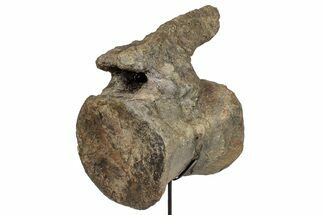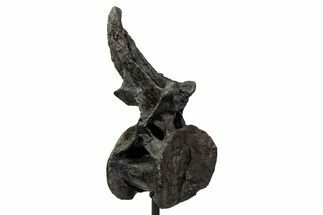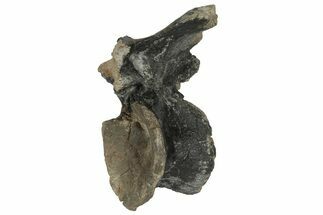14" Fossil Sauropod (Camarasaurus) Dorsal Vertebra - Wyoming
This is a 14" tall, fossil sauropod (Camarasaurus sp.) dorsal vertebra from the Morrison Formation, collected from the Red Canyon Ranch/Simon Quarry in Wyoming. The bone is largely free of the surrounding rock and in stable condition. This specimen has been compressed due fossilization and geologic forces.
Comes with a metal display stand.
A portion of the neural canal remained intact, though the everything superior to the pedicles is missing. There are several spots of glue stabilization, primarily along the inferior side of the vertebra. No significant gap fill restoration to this specimen.
Comes with a metal display stand.
A portion of the neural canal remained intact, though the everything superior to the pedicles is missing. There are several spots of glue stabilization, primarily along the inferior side of the vertebra. No significant gap fill restoration to this specimen.
About Camarasaurus
Camarasaurus was a medium-sized sauropod dinosaur whose fossils are found in the Morrison Formation of the Southest United States. It is estimated to have reached lengths of up to 75 feet long and had an estimated maximum weight of around 50 tons. Compared to contemporary Diplodocids, it had a shorter tail, longer forelimbs, and a much larger and more robust skull.
Camarasaurus skulls are quite distinctive: they have blunt snout and quite a square shape. Camarasaurus had large, spoon-shaped teeth, unlike many sauropod dinosaurs that had small, peg-like teeth. This likely indicates that it ate coarser vegetation, allowing it to share the same environment as other sauropods without competing for food. It may have replaced its teeth approximately every 60 days as they became worn from chewing. Its cervical vertebrae had hollow chambers to reduce weight on the neck, leading to its name, which means “chambered lizard”.
Camarasaurus is considered the most abundant of the sauropod dinosaurs found in North America. Its fossils have been found in almost every major Morrison Formation dinosaur locality, with fossils found in localities from across many states including New Mexico, Utah, Colorado, Montana and Oklahoma.
Camarasaurus was a medium-sized sauropod dinosaur whose fossils are found in the Morrison Formation of the Southest United States. It is estimated to have reached lengths of up to 75 feet long and had an estimated maximum weight of around 50 tons. Compared to contemporary Diplodocids, it had a shorter tail, longer forelimbs, and a much larger and more robust skull.
Camarasaurus skulls are quite distinctive: they have blunt snout and quite a square shape. Camarasaurus had large, spoon-shaped teeth, unlike many sauropod dinosaurs that had small, peg-like teeth. This likely indicates that it ate coarser vegetation, allowing it to share the same environment as other sauropods without competing for food. It may have replaced its teeth approximately every 60 days as they became worn from chewing. Its cervical vertebrae had hollow chambers to reduce weight on the neck, leading to its name, which means “chambered lizard”.
Camarasaurus is considered the most abundant of the sauropod dinosaurs found in North America. Its fossils have been found in almost every major Morrison Formation dinosaur locality, with fossils found in localities from across many states including New Mexico, Utah, Colorado, Montana and Oklahoma.
$750
SPECIES
Camarasaurus sp.
LOCATION
Red Canyon Ranch/Simon Quarry, Wyoming
FORMATION
Morrison Formation
SIZE
14 x 12 x 5.6"
CATEGORY
SUB CATEGORY
ITEM
#304823
We guarantee the authenticity of all of our specimens.
 Reviews
Reviews














